| 2010 Delhi Rashtra Mandal Khel - The Good |
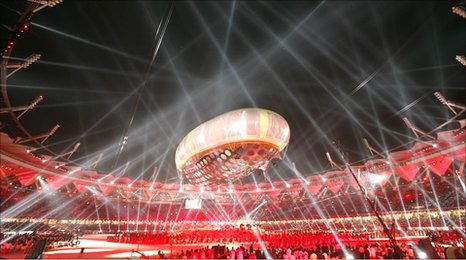
Commonwealth Games Opening Ceremony - Photo Courtesy BBC News
 midst all the negative press about the 2010 Delhi Rashtra Mandal Khel or Commonwealth Games, there are a few things that did go right, and are highlighted below. midst all the negative press about the 2010 Delhi Rashtra Mandal Khel or Commonwealth Games, there are a few things that did go right, and are highlighted below.
Infrastructure Projects
At least 3 major infrastructure projects associated with the Games were completed before schedule:
The new Terminal 3 at the Indira Gandhi International Airport, built at a cost of $2.8 million, opened in June 2010, four months ahead of schedule. GMR Group, which led the consortium to build the airport, had to work with 58 state and Central government agencies to get the job done in time. - Larger than the new terminals of Mumbai, Hyderabad and Bangalore combined, it is said to be the world's 6th largest passenger terminal and is expected to handle 34 million passengers annually.
The terminal has 168 check-in counters, 78 aerobridges at 48 contact stands, 30 parking bays, 72 immigration counters, 15 X-ray screening areas, for less waiting times, duty-free shops, 7 levels of automated parking amongst other features
Delhi Metro, a state-owned company, laid 125 km of Metro track in less than 5 years to meet the Commonwealth Games deadline. Credit for meeting the schedule goes to a large extent to Delhi Metro chief executive E. Sreedharan, who treats targets as sacrosanct. - The Metro not only proved to be sustainable in its delivery of services like hygiene, air-conditioning and punctuality.
Major Dhyan Chand National Stadium, revamped at the cost of Rs. 266 crores, became the first Commonwealth Games to be unveiled (on January 24, 2010). It even successfully hosted the 2010 Men's Hockey World Cup, which was a valuable tournament/security rehearsal for the Commonwealth Games. The largest crowds of the Commonwealth Games were at this stadium, where capacity crowds of around 19,000 witnessed some of the key Indian matches.
Opening Ceremony
The Opening Cerermony was a spectacular, dazzling and vibrant production. A colourful aerostat with a bevy of dancing puppets that lifted into the night sky to the sounds of over 800 drums, was the showpiece of the ceremony. The six classical dances of India were represented - Bharata Natyam, Kathak, Kuchipudi, Manipuri, Mohini Attam and Odissi. There was a segment on what India has given to the world, like yoga. The Tree of Knowledge showed India's guru-shishya parampara. There was the Great Indian Journey, where a train made a grand arrival in rhythm to the bamboo dance of the Cheraw dancers from Mizoram. A tribute to Mahatma Gandhi, the Father of the Nation, was paid through the playing of the Mahatma's favourite hymn - Vaishnavo Janato. 5000 years of Indian history, culture and tradition were showcased in a grand opening ceremony.
Media Facilities (courtesy Arumugam of Stick2Hockey.com)
There are 65 workstations with internet facilities at Pitch I of the Dhyan Chand Stadium, and 28 workstations at Pitch II. Every journalist is given the option of taking landline internet, or a free wireless data card.
Each press tribune table accommodates three chairs, with a plasma television that has two channels. One channel telecasts matches in the Dhyan Chand stadium, while the other channel shows the other Commonwealth Games events at other venues being telecast on Doordarshan Sports.
The stadium has an area for press conferences, duplication and documentation facilities, and Infostratda's General News Services that gives you flash quotes, statistics, daily summary and write ups.
The media lounge has free eatables and beverages. About 12 hours in a day, you are served with hot beverages, sandwiches, sweets, muffins, fruit juices and soft drinks.
The entire media area is air-conditioned, and the entire flooring is granite or marble. Media staff and volunteers are available at your beck and call for any help required.
The Commonwealth Games accreditation media card gives you unlimited free city travel on road and rail; Delhi Transport Company (DTC) buses and Delhi Metro.
It will take a long long time for other event organisers to surpass the benchmarks that this Commonwealth Games has set. Former hockey journalist Manish Kumar, in his role as Deputy Director General and Head, Press Operations, Commonwealth Games, worked almost two years to conceptualise, plan and execute the media facilities in a precise manner.
|
| 2010 Delhi Rashtra Mandal Khel - The Bad |

Collapsed Footbridge near the Javaharlal Nehru Stadium
Photograph by Mustafa Quraishi of AP
 he 2010 Delhi Rashtra Mandal Khel or Commonwealth Games has got worldwide negative media coverage, most of it deservedly so, due to the reasons listed below. he 2010 Delhi Rashtra Mandal Khel or Commonwealth Games has got worldwide negative media coverage, most of it deservedly so, due to the reasons listed below.
Jugaad
Jugaad, the Hindi word for improvising, should be banned from India's infrastructure lexicon. We cannot use Jugaad to build airports, stadiums and housing. India had 7 years to develop the Games Village, but it literally came to the last minute before the Village was operational. India could not deliver gracefully on this major international committment.
At least 21 Central Government departments were involved with the construction projects for the Games. Often times, the departments maintained different sets of timelines for the same construction project. As a result, almost all construction projects were revised and the deadlines pushed back, at least 3 times. The final cost of the games, at 100 times over the initial estimates, was due to poor management, poor leadership and lack of vision.
Collapsing Footbridge
It took 7 years and Rs. 5 crores for a company to build a Foot Overbridge (FOB) connecting Safdarjung Airport to the Javaharlal Nehru Stadium, which promptly collapsed on September 21, just before the start of the Commonwealth Games. 27 workers were injured.
A desperate Commonwealth Games Organising Committee and the Delhi government made an SOS call to Bharatiya Sena (Indian Army). Over 700 combat engineers from the Madras Engineering Group (a regiment of the Corps of Engineers), built a temporary Bailey Bridge in 4 days flat, and at a fraction of the original cost. The bridge has 3 piers, and 4 spans spread over 250 feet.
The Chandigadh-based company that built the collapsed foot overbridge has been blacklisted by the Delhi government.
Corruption
The Comptroller and Auditor General (CAG) and the Central Vigilance Commission (CVC) exposed cases of rampant corruption in Games-related projects. It started with the scam related to the launch of the Queen's Baton Relay (QBR) in London, soon followed by the 'outlays' scandal, in which items like air conditioners and treadmills were hired at tripe the cost.
There is also the issue of bribery. Delhi won the vote back in 2003 to host the 2010 Commonwealth Games in part due to a $100,000 training grant promised to each of the 70 participating nations. This $7 million dollars of training grants came out of Indian taxpayer's pockets, is the equivalent of paying 70 bribes, and should not be resorted to in the future.
|
| 2010 Delhi Rashtra Mandal Khel - The Ugly |
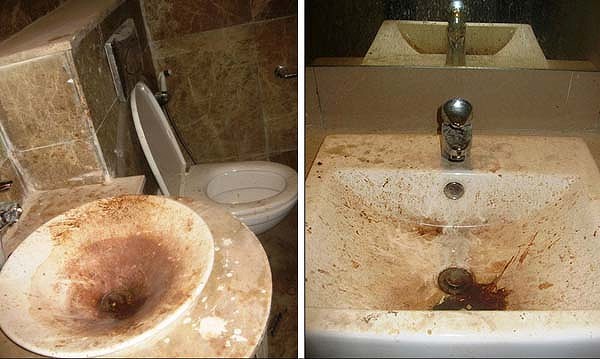
Hygiene has no nationality
 nternational sports officials who were taken on a Commonwealth Games Village tour saw rooms filled with construction debris, walls stained with betel leaft spit, and excrement in the toilets and sinks. nternational sports officials who were taken on a Commonwealth Games Village tour saw rooms filled with construction debris, walls stained with betel leaft spit, and excrement in the toilets and sinks.
Scottish officials claimed that their accommodation was "unsafe and unfit for human habitation". Welsh officials found two dogs sleeping on the beds meant for the athletes. The dogs then jumped off the bed and went into the shower unit for their toilet, and then jumped back on to the bed.
Organising Committe secretary Lalit Bhanot's reponse to the Scottish and Welsh officials' concerns was: "Everyone has different standards about cleanliness. The Westerners have different standards while Indians have different standards."
Failure on Lalit Bhanot's part to recognise that hygiene has no nationality is downright ugly. The bathrooms in Lalit Bhanot's house may look like the above, but such standards are not acceptable to the civilized world.
The Hindustan Times in a poll taken of Delhi residents found that 68% of Delhi residents felt that the Commonwealth Games event gave them a sense of shame.
The Times of India said in a front-page editorial, "India has been shamed globally. The guilty must be identified and brought to book. While that may not restore our reputation, it will show that we, as a nation, value our honour."
The Daily Telegraph of London ran a mocking series, "What's wrong in Delhi today?" The strapline said, "Empty stands, blocked lavatories, collapsing scoreboards, vomiting swimmers and striking officials, it's been a shocking few days for CWG organizers".
The Toronto Star, Canada's highest circulation newspaper, had a report headlined, "Commonwealth Games' latest bug: Pool making swimmers sick". This was after 40 of the 66 British swimmers competing in Delhi (representing, England, Scotland, Wales and Northern Ireland) went down with stomach upsets.
The Mail and Guardian from South Africa reported a chef de mission complaining about the opening ceremony, "Athleted were treated like cattle. Athletes were forced to wait in the searing heat in the tunnel before they could appear in the stadium. It was disgraceful."
When a tourist visiting a foreign country gets a stomach bug for the water, food or lack of sanitation, it could mean a few extra hours of rest, and missing a tourist attraction or two.
But for an athlete, it is a disaster. Athletes have spent four years of unwavering commitment to their sport in order to partcipate in the Delhi Games, only to be undone by a stomach bug. A case in point is Australian swimmer Hurley, who got an upset stomach during the Games, and eventually lost the Gold by a 10th of a second.
Filth, disrepair and squalor, unfinished venues, corporate mismanagement, corruption and lack of hygiene have no place in India shining. This was the ugly truth that the 2010 Commonwealth Games revealed.
Mabye it was only fitting that Organising Committee chairman Suresh Kalmadi was the only person booed during the Opening Ceremony of the Games. A joke that was widely circulated via email stated that Suresh Kalmadi tried to hang himself in shame, but failed because the ceiling on which he hung himself collapsed. This was after a ceiling actually collapsed in the Commonwealth Games Village.
|
| Karnataka (men) and Haryana (women) Win Jr. National Hockey Championships |
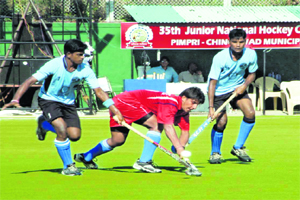 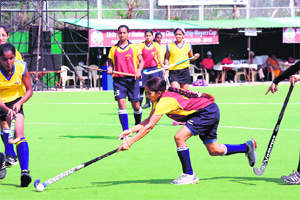
Photographs courtesy Indian Express
 he 35th Junior National Hockey Championship (men) and the 38th Junior National Hockey Championship (women) were simultaneously held at the Major Dhyan Chand poligras ground in Pimpri (for boys) and at the Shiv Chhatrapati Sports Complex in Balewadi (girls), from September 25 to October 6. This was the first time that the junior hockey nationals were being held in the Pune metropolitan area. he 35th Junior National Hockey Championship (men) and the 38th Junior National Hockey Championship (women) were simultaneously held at the Major Dhyan Chand poligras ground in Pimpri (for boys) and at the Shiv Chhatrapati Sports Complex in Balewadi (girls), from September 25 to October 6. This was the first time that the junior hockey nationals were being held in the Pune metropolitan area.
A total of 8 matches were played everyday at each of the venues during the league phases. In the boys championship, Karnataka and Punjab reached the final, with the following match results:
| Stage |
Date |
Karnataka |
Date |
Punjab |
| Pre-Quarters |
Oct 2 |
beat Mumbai 2-1 |
? |
? |
| Quarter-Finals |
Oct 3 |
beat Indian Oil 4-2 |
? |
? |
| Semi-finals |
Oct 5 |
beat SAIL 3-1 |
? |
? |
In the final played on October 6, Karnataka, captained by S. K. Uthappa, defeated Punjab 2-0 to win the boys junior national hockey championship. Earlier, Haryana beat Steel Authority of India (SAIL) 4-1 to finish third.
Punjab was also the losing finalist in the previous edition of the junior mens nationals that were held in Chennai back in 2007.
In the girls championship, Haryana and Chandigadh reached the final, with the following match results:
| Stage |
Date |
Haryana |
Date |
Chandigadh |
| League |
|
|
Sep 29 |
beat PEPSU 8-0 |
| |
|
|
Sep 30 |
beat Manipur 7-0 |
| Quarters |
Oct 2 |
beat Karnataka 4-2 |
Oct 3 |
beat Jharkhand 2-1 |
| Semis |
Oct 5 |
beat Uttar Pradesh 3-0 |
Oct 5 |
beat Punjab 2-2 (4-3), TB |
In the final played on October 6, Haryana beat Chandigadh 5-0 win to win the girls junior national hockey championship. Earlier, Punjab overcame Uttar Pradesh 3-2 to finish third.
The win helped the Haryana girls complete a hat-trick of national championships. They had earlier won the nationals in 2006 at Jabalpur and in 2007 at Gvalior. The championship was not held in 2008 and 2009.
The following were the tournament awards:
| Category |
Girls Championhip |
Boys Championship |
| Goalkeeper of the Tournament |
Savita (Haryana) |
Ankit Gulia (Haryana) |
| Full-back of the Tournament |
Nidhi Tripathi (Uttar Pradesh) |
Deepak Kullu (SAIL) |
| Half-back of the Tournament |
Etwari Mundu (Jharkhand) |
Mohammad Imran (UP) |
| Forward of the Tournament |
Shivani (Chandigadh) |
Akashdeep Singh (Punjab) |
| Player of the Tournament |
Raman Kaur (Haryana) |
Nikkin Thimmaiah (Karnataka) |
Prize money of Rs. 50,000 for the winners, Rs. 25,000 for the runners-up and Rs. 10,000 for third place, in both the boys and girls categories, along with trophies, were awarded by the organisers.
|
| ONGC Win 40th Gurmeet Memorial Hockey Tournament |
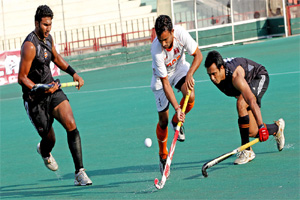
Semi-final between ONGC and Indian Oil
Photograph courtesy Indian Express
 he 40th S. N. Vohra Gurmeet Memorial Hockey Tournament was held at the Sector 42 hockey stadium in Chandigadh, from September 22 to September 30. he 40th S. N. Vohra Gurmeet Memorial Hockey Tournament was held at the Sector 42 hockey stadium in Chandigadh, from September 22 to September 30.
Oil and Natural Gas Commission (ONGC) and Sthal Sena (Army) reached the final of the tournament, with the following match results:
| Stage |
Date |
ONGC |
Sthal Sena (Army) |
| Quarters |
Sep 27 |
beat Rail Coach Factory 5-2 |
beat Punjab National Bank 3-3 (7-5), TB |
| Semis |
Sep 29 |
beat Indian Oil 4-4 (8-7), TB |
beat Punjab & Sindh Bank 2-1 |
In the final played on September 30, ONGC beat Sthal Sena 2-1 to win the 40th Gurmeet Memorial Hockey Tournament.
The winners who led 2-0 at half time scored through Jagvant Singh (20 min) and Diwakar (26 min, PC). Sena reduced the margin in the 57th minute, when Ponappa converted a penalty corner.
The winners were presented a trophy and a cheque for Rs. 75,000, while the runners up got a pay cheque of Rs. 50,000. Punjab minister Parminder Singh Dhindsa presented the prizes.
The tournament awards were as follows:
- Best Goalkeeper: Dinesh Ekka (ONGC)
- Best Full-back: Rupinder Pal Singh (Indian Overseas Bank)
- Best Half-back: Preetinder Singh (ONGC)
- Best Forward: Arumugam (Sthal Sena)
Each of the above individual awardees got a cash prize of Rs. 2,000. Indian Overseas Bank (Chennai) was adjudged the best behaved team of the tournament.
|
| Photograph of the Month |
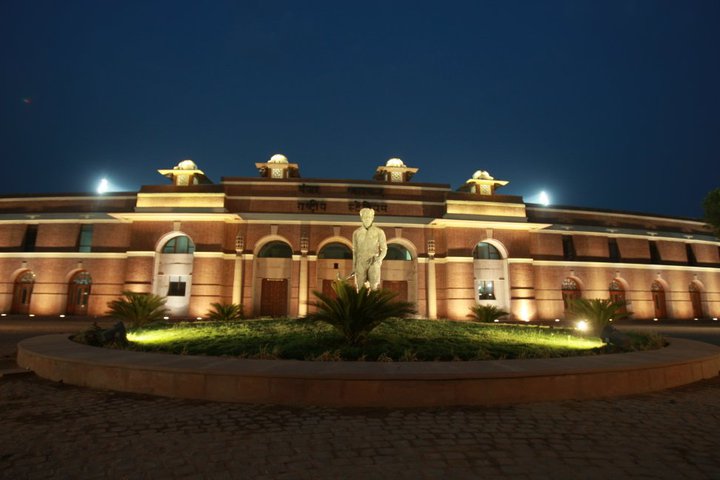
Photograph courtesy Stick2Hockey.com
 he Photograph of the Month for October 2010 is a night shot of the Major Dhyan Chand National Stadium. Just as Michael Jordan is captured in flight outside Chicago's United Center and Wayne Gretzky is enshrined in front of the Staples Center in Los Angeles, Major Dhyan Chand is immortalized in front of the historic stadium named after him. he Photograph of the Month for October 2010 is a night shot of the Major Dhyan Chand National Stadium. Just as Michael Jordan is captured in flight outside Chicago's United Center and Wayne Gretzky is enshrined in front of the Staples Center in Los Angeles, Major Dhyan Chand is immortalized in front of the historic stadium named after him.
The beautiful red-brick building offers a breathtaking view of the India Gate, the country's national war memorial that commemorates the 90,000 soldiers of the British Indian Army who lost their lives in World War I and in the Third Anglo-Afghan War.
Some of the major events held at the Major Dhyan Chand National Stadium include:
- 1951 - Inaugural Asian Games
- 1982 - Asian Games hockey tournament
- 2010 - World Cup Hockey tournament
- 2010 - Commonwealth Games Hockey tournament
The stadium has undergone the following name changes:
- 1933 - Irwin Amphitheatre
- 1951 - renamed to National Stadium
- 2002 - renamed to Major Dhyan Chand National Stadium
|
| Money Matters |
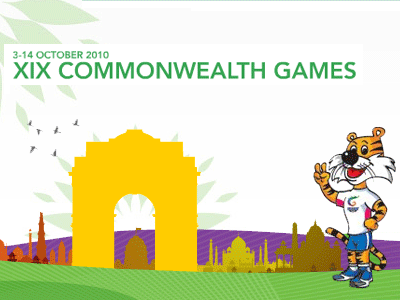
 he following are the Lead Partners, Partners, Sponsors and Co-Sponsors for the 2010 Delhi Commonwealth Games: he following are the Lead Partners, Partners, Sponsors and Co-Sponsors for the 2010 Delhi Commonwealth Games:
| LEAD PARTNER |
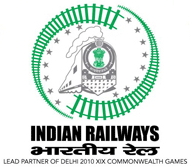 |
| PARTNERS |
 |
 |
 |
 |
| SPONSORS |
 |
 |
| CO-SPONSORS |
 |
 |
 |
 |
A note on the Lead Partner - Bharatiya Rail. The organisation was the winner of the first "Rashtriya Khel Protsahan Puraskar", instituted by the Government of India. Around 90 sportspersons from Indian Railways participated in the 2010 Delhi Commonwealth Games 2010, the biggest contingent from a single organisation in the country.
|
| Media Matters |
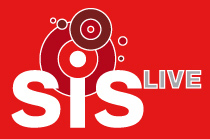
 IS Live, Europe's largest outside broadcast and uplink producer, is the television production network of the Delhi Commonwealth Games. Their multi-million dollar contract with Doordarshan included coverage of 17 sports events across 12 competition venues, as well as the Opening and Closing ceremonies. IS Live, Europe's largest outside broadcast and uplink producer, is the television production network of the Delhi Commonwealth Games. Their multi-million dollar contract with Doordarshan included coverage of 17 sports events across 12 competition venues, as well as the Opening and Closing ceremonies.
SIS utilised the services of over 1,200 skilled technicians, production crew and support staff drawn from across the world for their Games coverage. SIS Live provided the 'Basic Feed' for the Games, which comprised live television pictures and sound, (English) commentary, titling, timings and results, slow motion replays, special effects and onscreen credits. Doordarshan provided the Hindi commentary. In addition, SIS Live also provided 2 daily highlights packages of an hour's duration each.
If the 1982 Delhi Asian Games introduced colur television to India, the 2010 Commonwealth Games introduced High Definition telecast to India. SIS Live provided High Definition coverage at 1920 x 1080/50i in 16:9 wide screen, the first time the Commonwealth Games were broadcast in HD..
SIS Live deployed 350 High Definition cameras and 100 High Definition long lenses to cover the mega sporting event, using a range of cameras like heli-cams, plunge-cams and wire-cams. Heli-Cams, cameras fitted on helicopters, were used for aerial shots and during the marathons, giving a bird’s eye view of the events. Plunge-Cams were used under the pool in the swimming events, providing a fish-eye view of proceedings. Wire-Cams provided a competitor's perspective to all the athletic action on the track.
Cameras were also installed near landmarks like the Qutab Minar, India Gate, the Jawaharlal Nehru Stadium and high rises in Connaught Place, to show vantage views of Delhi. The production team had 25 mobile camera units to interview athletes.
Delays in construction of the stadiums did affect the preparations of the production team. SIS Live wanted to install their equipment at the venues at least 45 days in advance and start test runs. However, they got the venues just days before the global event.
Doordarshan was the host broadcaster, and had exclusive broadcasting rights in India. Doordarshan Sports became a 24-hour Commonwealth Games channel during the event. Private Indian television channels were allowed up to 3 minutes of Games footage a day.
Fox Sports had the broadcasting rights for Australia, and Sky Sports for the United Kingdom.
|
| Visitor of the Month |
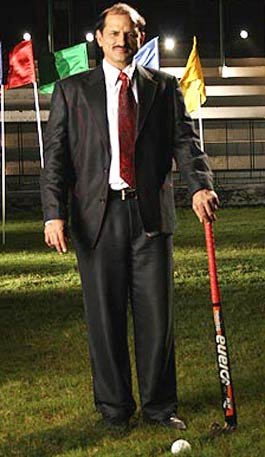
 he October 2010 Visitor of the Month is hockey player Mir Ranjan Negi, the inspiration behind the hit movie Chak de India. Mr. Negi wrote the following to BharatiyaHockey.org: he October 2010 Visitor of the Month is hockey player Mir Ranjan Negi, the inspiration behind the hit movie Chak de India. Mr. Negi wrote the following to BharatiyaHockey.org:
It is really wonderful to see this website showing so much of zeal and enthusiasm for our National Sport. I have noted how you deal with serious issues; you are not biased in your approach towards anyone.
More time needs to be given to continuously upgrade the information available on the site. Bharatiyahockey.org should have more articles before any major tournaments like the World Cup or the upcoming Commonwealth Games.
I feel more former players should contribute in sending their opinions and views on the current state of Indian Hockey.
|
| Fun With Numbers |

Statistics by B. G. Joshi
 his month's edition of Fun with Numbers deals with country records in the Commonwealth Games men's and women's hockey competitions, prior to the October 2010 edition in Delhi. his month's edition of Fun with Numbers deals with country records in the Commonwealth Games men's and women's hockey competitions, prior to the October 2010 edition in Delhi.
COMMONWEALTH GAMES MEN'S HOCKEY TOURNAMENT
6 of the world's top 10 teams are participating in the 2010 men's tournament - world ranked 1 (Australia), 4 (England), 7 (New Zealand), 8 (Pakistan), 9 (India) and 10 (Canada). So the men's tournament will be seeing a high level of competition.
Australia has 100% success in the Commonwealth Games men's hockey tournament. The tournament has been held 3 times, and Australia has won the gold all 3 times. 3 different countries have met Australia in the men's hockey final - Pakistan (2006), New Zealand (2002) and Malaysia (1998) - and none of them could prevent Australia from winning the gold.
| Year |
Venue |
Gold |
Silver |
Bronze |
Top Scorer |
| 1998 |
Kuala Lumpur |
Australia |
Malaysia |
England |
Greg Nicol (SAF), 14 goals |
| 2002 |
Manchester |
Australia |
New Zealand |
Pakistan |
Hayden Shaw (NZL), 13 goals |
| 2006 |
Melbourne |
Australia |
Pakistan |
Malaysia |
Sandeep Singh (IND), 7 goals |
India has 0% success in the Commonwealth Men's Hockey Tournament. India failed to qualify once (2002), failed to make it to the semi-finals once (2006), and returned 4th and medal less the other time (1998).
14 Indian men have scored a total of 37 goals in the Commonwealth Men's Hockey Tournament. The top 5 goal scorers are: Sandeep Singh (7), Baljeet Singh Dhillon (6), Dhanraj Pillai (5), Lakshman Prabhakaran (4) and Deepak Thakur (3).
The country records of the men's teams taking part in the 2010 men's hockey tournament are given below:
| POOL |
WORLD RANK |
COUNTRY |
APPEARANCES |
BEST FINISH |
| A |
1 |
Australia |
3 |
3 Golds (1998, 2002, 2006) |
| |
8 |
Pakistan |
3 |
1 Silver (2006) |
| |
9 |
India |
2 |
4th (1998) |
| |
15 |
Malaysia |
2 |
1 Silver (1998) |
| |
23 |
Scotland |
1 |
7th (2006) |
| B |
4 |
England |
3 |
1 Bronze (1998) |
| |
7 |
New Zealand |
3 |
1 Silver (2002) |
| |
10 |
Canada |
3 |
5th (1998) |
| |
12 |
South Africa |
3 |
4th (2002) |
| |
29 |
Trinidad & Tobago |
2 |
10th (2006) |
COMMONWEALTH WOMEN'S HOCKEY TOURNAMENT
Only 3 of the world's top 10 teams are participating in the 2010 women's tournament - world ranked 5 (England), 6 (Australia) and 7 (New Zealand). The list of medal winners in the women's competition in the 3 events held thus far are as follows:
| Year |
Venue |
Gold |
Silver |
Bronze |
Top Scorer |
| 1998 |
Kuala Lumpur |
Australia |
England |
New Zealand |
Alyson Annan (AUS), 11 goals |
| 2002 |
Manchester |
India |
England |
Australia |
Pietie Coetzee (SAF), 10 goals |
| 2006 |
Melbourne |
Australia |
India |
England |
Nikki Hudson (AUS), 5 goals
Sarah Taylor (AUS), 5 goals
Angela Skirving (AUS) , 5 goals |
Gender Inequality - Pakistan is the only country that is participating solely in the men's tournament. All other 9 countries that are in the men's tournament have also qualified for the women's tournament.
Gender Equality - Australia and England are the two highest ranked teams in the men's tournament. Australia and England are also the two highest ranked teams in the women's tournament.
16 Indian women have scored a total of 50 goals in the Commonwealth Women's Hockey Tournament. The top 5 goal scorers are: Preetam Rani Sivach (9), Mamta Kharab (7), Jyoti Sunita Kullu (6), Seeta Gossain (4) and Jasjeet Kaur Handa/Kamala Dalal/Suman Bala (all 3).
The country records of the women's teams taking part in the 2010 women's hockey tournament are given below:
| POOL |
WORLD RANK |
COUNTRY |
APPEARANCES |
BEST FINISH |
| A |
6 |
Australia |
3 |
2 Golds (1998, 2006) |
| |
11 |
India |
3 |
1 Gold (2002) |
| |
12 |
South Africa |
3 |
5th (1998-Joint, 2002) |
| |
23 |
Scotland |
3 |
5th (1998-Joint, 2006) |
| |
26 |
Trinidad & Tobago |
1 |
10th (1998) |
| B |
5 |
England |
3 |
2 Silver (1998, 2002) |
| |
7 |
New Zealand |
3 |
1 Bronze (1998) |
| |
19 |
Canada |
3 |
7th (1998, 2002) |
| |
22 |
Malaysia |
3 |
6th (2006) |
| |
28 |
Wales |
1 |
9th (1998) |
|
![]()